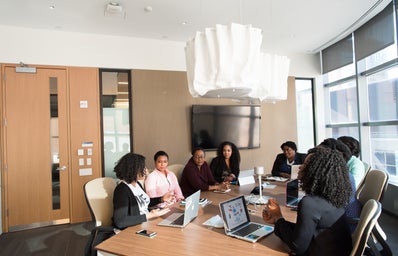Diversity, equity and inclusion are words you’ve probably heard all over the internet and in your day-to-day life lately. As we continue to fight against racial injustice and move toward a more equitable future for everyone, the terms have continued to gain traction. According to Google Trends, all three words hit a peak in June following the murder of George Floyd and have maintained a high search rate ever since.
Many companies and organizations have implemented or revamped their diversity and inclusion initiatives to ensure that all different voices are heard, not just those that are inherently privileged in our society. And this is a good thing. Embracing diversity, equity and inclusion isn’t just the right thing to do, it’s good for business too. Getting input from people with all different identities and backgrounds makes the workplace a more well-rounded space to be in and allows for tons of creative ideas to flow.
That said, diversity, equity and inclusion are things that can’t be achieved half-heartedly or completed with what Nicole Anad, a political economist, calls “checkbox” approaches. Checkbox approaches are stale approaches that don’t actually lead to an improvement in this area; in other words, things like unconscious bias training or hiring to fill a diversity spot.
For a lot of us just entering the workforce or already in it, making sure that our workplace has meaningful initiatives in place is very important. But if you’re like me, you might be new to your workplace or not in a position to make decisions regarding new initiatives. In my search for things I, and other young professionals, could do to make our own workplaces more diverse and inclusive for everyone, I spoke with Adriele Parker, a diversity, equity and inclusion strategist and career coach to find out the best recommendations.
Defining diversity, equity and inclusion

While these key terms can mean different things to different people, it helps to have common definitions. One set of definitions you might adopt comes from DEI Extension, a professional development committee offering from the eXtension Foundation Impact Collaborative. According to their website, diversity is the presence of differences; equity is promoting justice and fairness within an institution or system; inclusion is ensuring that those who are considered diverse actually feel welcomed.
Parker says that diversity, equity, and inclusion – particularly in the workplace – are strategies that should be treated like any other business initiative and invested in.
Evaluate your workplace
Understanding your workplace and knowing where there’s space for initiatives is a crucial step toward determining if you, as a young professional, can make a difference. This will help you to see what you need to be vocal about, and will let you take note of what’s happening in your environment. Don’t be afraid to ask higher-ups the hard questions like what your company is doing to promote the cause. This will help you understand not only what’s already available, but where you might be able to make a contribution.
Usually, companies offer groups where people with specific identities can come together and if you can, joining one is a great way to notice what is happening. For example, some companies have groups for LGBTQ+ community members, women-identifying people, ethnic and racial minority groups, and so on.
Part of evaluating your workplace is listening to your coworkers’ stories and experiences. Being social allows you to understand what barriers may stand in the way of those who are marginalized, what their experience in your workspace space is like, and what the culture is like in your workplace for other people. This kind of social interaction can help you gather ideas about how you can be a good support system for those who are marginalized, and/or how your workplace can change to best support these individuals. Note that this takes a lot of vulnerability, so you should also be okay with people not wanting to share their experiences with you!
What you can do
Besides things like gathering data and being mindful of your experiences alongside those of others, here are a few more things that you can do to promote diversity, equity and inclusion in your workplace:
Join or start a group or committee
Join or start committees and support groups in which people with common experiences can feel comfortable sharing their stories. Again, some places have gatherings for LGBTQ+ employees, women employees, or ethnic and racial minority employees, but really you can start a group around anything you want (like a diverse authors book club)!
Many workplaces already have groups in place, but if they don’t, one idea is to start a group so people can come together to give and receive support.
Call out inequities
Keep an eye out for fairness, and call attention to things that aren’t equitable
If you see something that’s unfair, speak up, especially if you are in a privileged position. If speaking up sounds terrifying to you, you can always check in with people later on or bring your concerns to your supervisor or human resources department. They should be able to take over your situation or advise you. Be aware of your surroundings and ensure that your workplace is a safe space for everyone.
Keep educating yourself and those around you
Making your workplace more diverse, equitable and inclusive is not a one-and-done situation. It’s going to take time, energy, and continuous unlearning and relearning for a lot of people. One of the best ways that young professionals can contribute to making this possible is being open to changing your mindset. Plus, there are tons of resources out there to choose from and to continue learning from like Parker’s Diversity, Equity, & Inclusion Community Resource List.
Tips for people with marginalized identities
As a person with marginalized identities, one of the things that frustrates me about a lot of diversity, equity, and inclusion initiatives is that they often get assigned to people with marginalized identities. While sometimes this is for good reason, it can be taxing work.
For employees with marginalized identities, one way to promote these initiatives while still protecting yourself is to decide how you want to be involved, and figure out how much you can and are willing to contribute. The fact of the matter is that these initiatives can’t be put into place without those of us who have marginalized identities. In order to establish initiatives that support our needs, it’s necessary to have both people who have marginalized identities and those who don’t. We know what’s best for us and we know the kind of support we need. At the same time though, be comfortable with setting boundaries and sticking to them. All the work shouldn’t be put on us to do it all.
Parker says, “This work can be frustrating, but remain patient! We don’t want to give implementation power to people who don’t understand our experiences.”
Tips for people without marginalized identities
For those of us who make up the majority, the best way to promote diversity, equity and inclusion is by becoming a good ally. “Good” is subjective, I know, but some of the most basic traits of a good ally include active listening, being an upstander rather than a bystander, amplifying the voices of others, and owning your mistakes. Being a good ally doesn’t mean that you have to understand exactly what your marginalized counterparts are going through, it just means that you take on their struggle and are willing to carry that weight with you. Parker recommends using something like The Guide to Allyship as a starting point for learning how to decenter your own experiences and do what you can to support and advocate for diversity.
This isn’t meant to be an exhaustive methodology for promoting diversity, equity and inclusion in your workplace, but it is meant to give you a place to start if you haven’t already. Don’t doubt that you, as a young professional, can make a huge difference!



